
current / archive / issues / faq / RSS feed / twitter /
Blog Archive: February 2019
Where Angels Fear To Tread!This issue carries on at the same furious pace as the last one, starting with Luke Cage fighting the entire Fantastic Four single-handed! He's gone to the Baxter Building to borrow a rocket, so he can fulfil the promise he made last time and go to Latveria to collect the money Doom owes him.
The Fantastic Four find the idea of anyone going to so much trouble to collect on a debt jolly amusing, which makes them an interesting contrast to the distinctly working class Luke Cage. To them, $200 is a negligible sum, but to a working man like him it's a lot. Also, there's the principle of the thing - he won't stand for being ripped off.
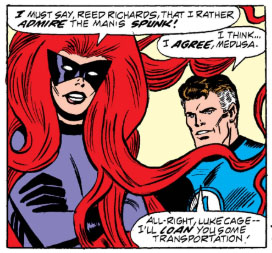 It's a neat bit of writing from Steve Engelheart which demonstrates how different Cage is from the first family of Marvel Comics, while also rather cleverly finding a way for the character to get over to the other side of the world.
It's a neat bit of writing from Steve Engelheart which demonstrates how different Cage is from the first family of Marvel Comics, while also rather cleverly finding a way for the character to get over to the other side of the world.
As soon as Cage arrives in Latveria his ship is stopped by Doctor Doom's security systems, and a platoon of guards runs out, expecting to be fighting the Fantastic Four. When they discover just one man they find the whole thing hilarious.
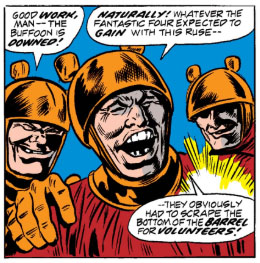 People laugh a lot at Cage in this story, and he never rises to the bait, fighting back with his fists rather than reacting to mockery.
Having said that, he can hardly resist commenting on the guards' costumes, which have completed their journey from Kirby's original terrifying robots to their current status as something out of "a crackerjack's box".
People laugh a lot at Cage in this story, and he never rises to the bait, fighting back with his fists rather than reacting to mockery.
Having said that, he can hardly resist commenting on the guards' costumes, which have completed their journey from Kirby's original terrifying robots to their current status as something out of "a crackerjack's box".
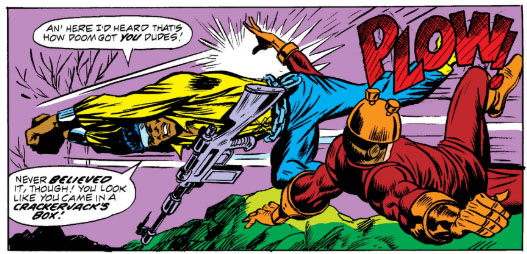 (for fellow non-Americans: it's a breakfast cereal that sometimes had free toys in the box)
(for fellow non-Americans: it's a breakfast cereal that sometimes had free toys in the box)
Suddenly a bunch of robots appear, similar to the ones Cage fought last time, and start killing the guards. Cage follows the robots and discovers that their leader is a very familiar figure... at least to those of us who have been reading a lot of Doctor Doom comics.
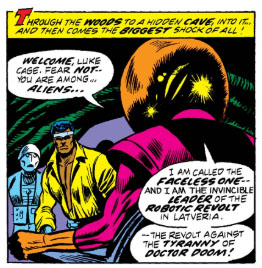 It's The Faceless One! The last time we saw him was way back in Astonishing Tales #3, which ended with him being "driven off by an earthquake." Back then he was trying to depose Doctor Doom by putting Prince Rudolfo on the throne, though it was never clear exactly why he was doing so. This time he has gathered an army of robot followers to try again, although his reasons remain as obscure as ever.
It's The Faceless One! The last time we saw him was way back in Astonishing Tales #3, which ended with him being "driven off by an earthquake." Back then he was trying to depose Doctor Doom by putting Prince Rudolfo on the throne, though it was never clear exactly why he was doing so. This time he has gathered an army of robot followers to try again, although his reasons remain as obscure as ever.
The Faceless One tries to persuade Cage to help him by comparing the robots' plight to slavery, but Cage is having none of it.
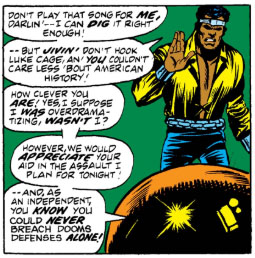 Once again, someone underestimates Cage's intelligence, and once again he immediately puts them right. He decides to help the robots invade the castle anyway, so that he can get to Doom, and George Tuska and Billy Graham kick off the attack with a fantastic panel.
Once again, someone underestimates Cage's intelligence, and once again he immediately puts them right. He decides to help the robots invade the castle anyway, so that he can get to Doom, and George Tuska and Billy Graham kick off the attack with a fantastic panel.
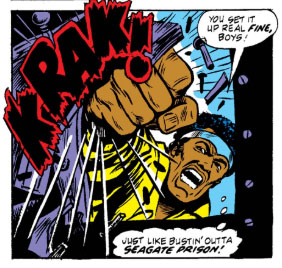 As the attack enters the castle Cage goes in search of Doom, who's relaxing on his throne. He says he's been expecting him, but is astonished to find out that this is not a scheme by Reed Richards, but a genuine attempt to force him to pay up.
As the attack enters the castle Cage goes in search of Doom, who's relaxing on his throne. He says he's been expecting him, but is astonished to find out that this is not a scheme by Reed Richards, but a genuine attempt to force him to pay up.
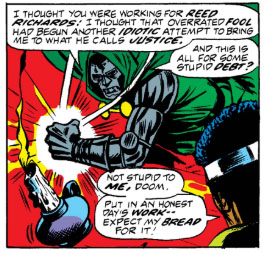 It's interesting that Doom, the arrogant supervillain, is not the first person to express disbelief at Cage's need to get paid. It's a running theme throughout the issue, as privileged white individuals (and, to be fair, a space alien too) laugh at the working class black man's demand to be treated fairly. This time it leads to a fantastic one-two panel.
It's interesting that Doom, the arrogant supervillain, is not the first person to express disbelief at Cage's need to get paid. It's a running theme throughout the issue, as privileged white individuals (and, to be fair, a space alien too) laugh at the working class black man's demand to be treated fairly. This time it leads to a fantastic one-two panel.
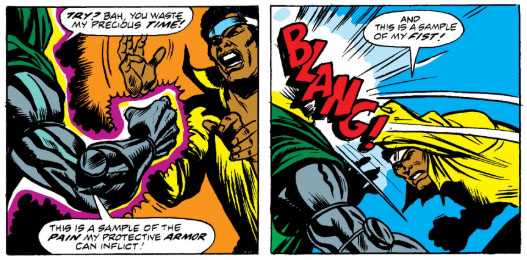 Is it me, or is this an inspiration for a much more famous sequence?
Is it me, or is this an inspiration for a much more famous sequence?
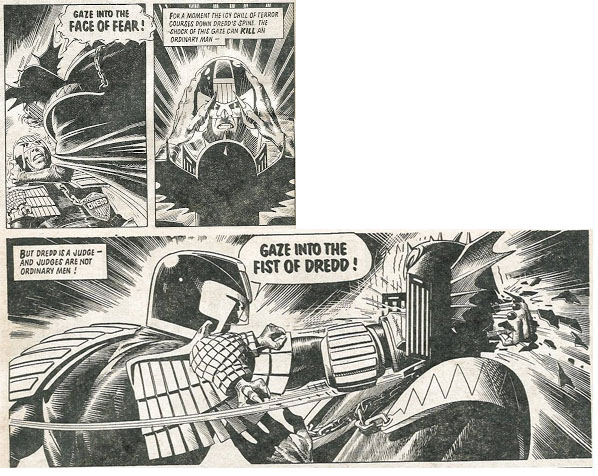 The two have a right proper punch-up, during which Cage hits on the secret weakness of Doom's armour - he has, in his own words, "forged my armor to withstand anything... except repeated stress on a solitary point!" This seems like a distinctly foolish error to make, and hardly fits in with Doom's usual forward thinking. It also gives The Faceless One the ideal opportunity assassinate Doom.
The two have a right proper punch-up, during which Cage hits on the secret weakness of Doom's armour - he has, in his own words, "forged my armor to withstand anything... except repeated stress on a solitary point!" This seems like a distinctly foolish error to make, and hardly fits in with Doom's usual forward thinking. It also gives The Faceless One the ideal opportunity assassinate Doom.
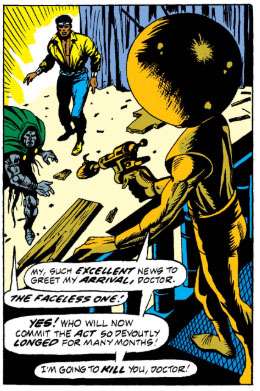 Doom leaps out of the way, giving Cage enough time to leap up onto the balcony and stop The Faceless One from trying again, because "murder's a gig I don't take kindly to." The Faceless One is forced to extract itself from its android body and flee again, off to goodness knows where without ever making it clear what it was trying to do in the first place. Doom demands that Cage follow him, but he quite rightly points out that he hasn't been paid for his first job yet.
Doom leaps out of the way, giving Cage enough time to leap up onto the balcony and stop The Faceless One from trying again, because "murder's a gig I don't take kindly to." The Faceless One is forced to extract itself from its android body and flee again, off to goodness knows where without ever making it clear what it was trying to do in the first place. Doom demands that Cage follow him, but he quite rightly points out that he hasn't been paid for his first job yet.
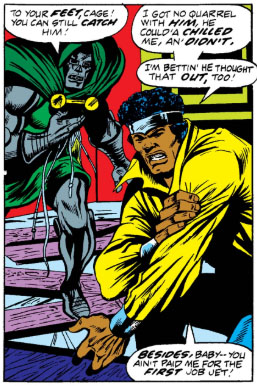 Doom find this absolutely hilarious, thanks him for saving his life, and duly pays up. This feels like a nice bit of characterisation, combining Doom's high-handed arrogance and superiority complex with a recognition of an honorouable individual, even though it does come off as massively patronising.
Doom find this absolutely hilarious, thanks him for saving his life, and duly pays up. This feels like a nice bit of characterisation, combining Doom's high-handed arrogance and superiority complex with a recognition of an honorouable individual, even though it does come off as massively patronising.
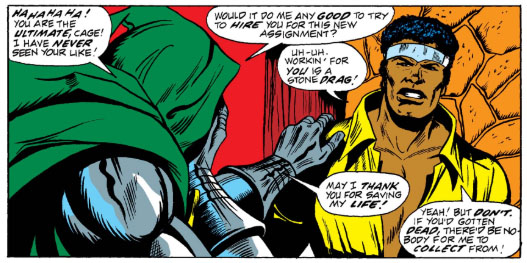 Cage heads off just as the robot rebellion enters Doom's inner sanctum, and it's only when he arrives back at the Baxter Building that we find out what happened, thanks to The Thing's newspaper.
Cage heads off just as the robot rebellion enters Doom's inner sanctum, and it's only when he arrives back at the Baxter Building that we find out what happened, thanks to The Thing's newspaper.
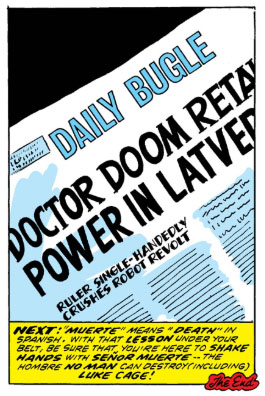 The newspaper is The Daily Bugle, which is of course the newspaper that Spider-Man works for. It's a nice touch which shows how rich the Marvel Universe has become, with it's own newspaper amongst many other aspects of the fictional storyworld. It's also a good end to a thoroughly enjoyable, frenetic, well-written and illustrated story that makes me want to read more Luke Cage!
The newspaper is The Daily Bugle, which is of course the newspaper that Spider-Man works for. It's a nice touch which shows how rich the Marvel Universe has become, with it's own newspaper amongst many other aspects of the fictional storyworld. It's also a good end to a thoroughly enjoyable, frenetic, well-written and illustrated story that makes me want to read more Luke Cage!
Other things to note about this issue are the fact that Doom's armour is still very much on-brand with the John Buscema design, and that his character is also in line with the Roy Thomas/Gerry Conway version as an honourable man, with the only hint of Stan Lee's deluded dictator coming in the rather petty refusal to pay his debts. It feels like this is definitely the direction Doom is moving in.
Next up an extremely weird cameo, in the one hundredth issue of 'Daredevil'!
posted 22/2/2019 by MJ Hibbett
(click here for permanent link)
(0) comments
Crescendo!
This is a comic I've read about a few times over the years, as various commentators have used it as an example of how silly comics can be. Reading it for myself for the first time, however, I'm struck by how exciting, action-packed and characterful it is. Luke Cage is absolutely bloody furious throughout most of the two-part story, with good reason, and this makes everything rocket along at high speed. It's not silly at all, it's brilliant!
The story starts with Luke recapping the previous issue whilst trashing his own offices in frustration with how his life is going. He's interrupted by a flashy looking fellow who wants to offer him a job, but Cage is too wrapped up in his current worries to pay too much attention, and sets off instead to chase a suspect across the streets. Some of the dialogue is a little "of its time", with multiple racial stereotypes at play, but it's a great example of high-octane comics with little in the way of superpowers.
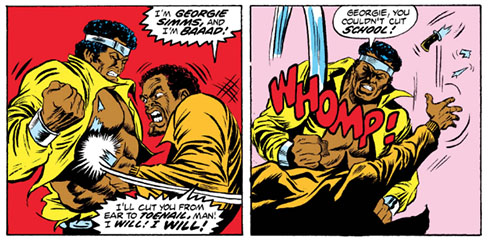 Eventually Luke loses his quarry, so he pops over to see his girlfriend, Claire Temple. Claire is a young, black, female doctor, which seems terribly modern, especially just a few years since the Fantastic Four were forever telling The Invisible Girl to get on with the washing up, although this is slightly let down by the fact that she immediately sews Luke's shirt up before hopping into bed with him.
Eventually Luke loses his quarry, so he pops over to see his girlfriend, Claire Temple. Claire is a young, black, female doctor, which seems terribly modern, especially just a few years since the Fantastic Four were forever telling The Invisible Girl to get on with the washing up, although this is slightly let down by the fact that she immediately sews Luke's shirt up before hopping into bed with him.
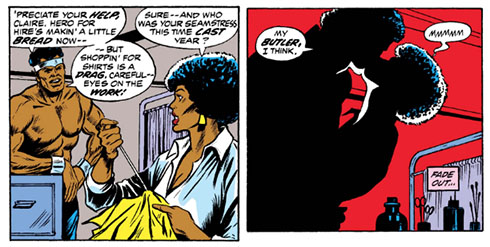 An hour later Luke is back on the street, where the mysterious well-dressed businessman from before returns to offer a lot of money to track some people down. Luke accepts the offer and very quickly finds the men he's after, who turn out to be robots!
An hour later Luke is back on the street, where the mysterious well-dressed businessman from before returns to offer a lot of money to track some people down. Luke accepts the offer and very quickly finds the men he's after, who turn out to be robots!
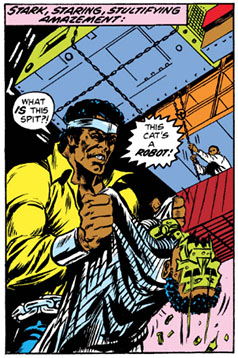 "What is this spit?" Is Luke in The Good Place?
"What is this spit?" Is Luke in The Good Place?
The robots escape, so Luke tracks down his contact, who he discovers dressed in full military uniform at an embassy party. The embassy, of course, turns out to be Latveria's, and the host is none other than Doctor Doom!
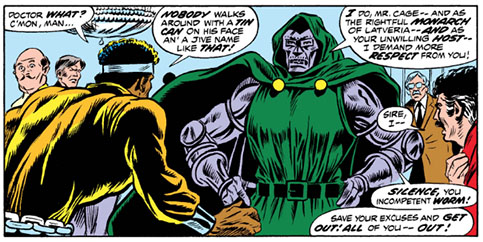 I do like the fact that Luke Cage refuses to believe that Doctor Doom is for real. It's a nice touch which reinforces the idea that Cage is a hero of the streets, with little do do with the traditional cosmic superheroics of the Marvel Universe. In a way he harks back to the early days of the storyworld, when aliens and robots weren't necessarily accepted as common occurrences.
I do like the fact that Luke Cage refuses to believe that Doctor Doom is for real. It's a nice touch which reinforces the idea that Cage is a hero of the streets, with little do do with the traditional cosmic superheroics of the Marvel Universe. In a way he harks back to the early days of the storyworld, when aliens and robots weren't necessarily accepted as common occurrences.
Also notable here is that this version of Doom looks almost exactly the same as the pin-up by John Buscema from last time, with only his pistol pouch missing. His character is also in line with recent developments, taking care of his subjects while openly expressing his superiority to them, and talking to Cage with respect rather than derangement. It's also here that we find the most famous panel from this issue, with Doom lamenting the fact that nobody ever seems to emigrate to Latveria.
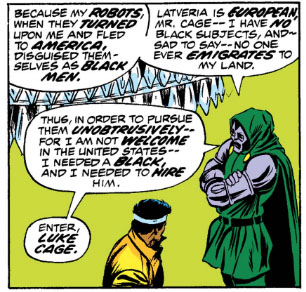 Cage heads off to find the robots again, leading to a gorgeous sequence where George Tuska and Billy Grahams get to depict a right old punch-up, with dialogue by Steve Engelheart which reminds me of early 2000AD stories.
Cage heads off to find the robots again, leading to a gorgeous sequence where George Tuska and Billy Grahams get to depict a right old punch-up, with dialogue by Steve Engelheart which reminds me of early 2000AD stories.
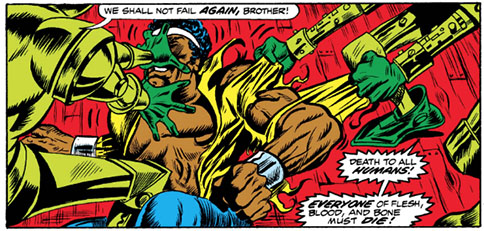 It's brilliant, funny, fluid storytelling that is miles away from the early days of Lee and Kirby, but very much in the same tradition of everyday worlds being invaded by the bizarre. This is underlined even further at the end of the story when Cage rushes back to the embassy to get paid, only to find that Doctor Doom has left without paying!
It's brilliant, funny, fluid storytelling that is miles away from the early days of Lee and Kirby, but very much in the same tradition of everyday worlds being invaded by the bizarre. This is underlined even further at the end of the story when Cage rushes back to the embassy to get paid, only to find that Doctor Doom has left without paying!
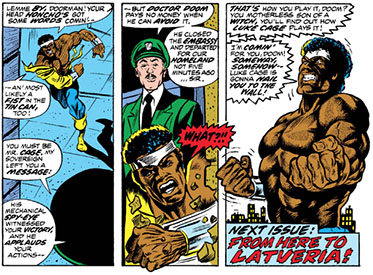 The only wrong note in this entire excellent comic is there at the end, when we're told that "Doctor Dooms pays no money when he can avoid it." This is not something we've ever seen before, and bears little relation to a character who's prepared to pour everything he's got into his latest inventions. I can see why it's there - to push us onto what happens in the next issue - but it sticks out as a wrong note in an otherwise thrilling issue. More please!
The only wrong note in this entire excellent comic is there at the end, when we're told that "Doctor Dooms pays no money when he can avoid it." This is not something we've ever seen before, and bears little relation to a character who's prepared to pour everything he's got into his latest inventions. I can see why it's there - to push us onto what happens in the next issue - but it sticks out as a wrong note in an otherwise thrilling issue. More please!
posted 15/2/2019 by MJ Hibbett
(click here for permanent link)
(0) comments
The Fabulous FF's Friends... and Foes!
This is yet another in a very long run of Doom appearances that don't feel like they should really 'count'.
This issue's story sees the Fantastic Four saving a local priest from the clutches of The Mole Man, who's kidnapped him to officiate at his marriage to Kala, Queen of The Netherworld. If this seems like a weird match, between the Officially Ugly Mole Man (it's part of his origin) and the beautiful Kala that's because, inevitably, Kala is simply playing the Mole Man, tricking him into marrying her so she can steal his subterranean kingdom and then cop off with the dreadful Tyrannus instead.
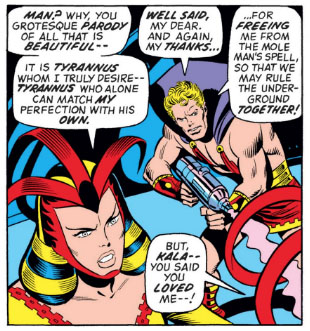 Tyrannus, frankly, seems like a dick. Mr Fantastic disguises himself as a Subterranean using his surprisingly little used ability to mold his facial features into a different shape so that he looks like somebody else. He also utilises some skin dye which he "thought might come in handy", which seems doubly odd given that he almost never uses this aspect of his superpower.
Tyrannus, frankly, seems like a dick. Mr Fantastic disguises himself as a Subterranean using his surprisingly little used ability to mold his facial features into a different shape so that he looks like somebody else. He also utilises some skin dye which he "thought might come in handy", which seems doubly odd given that he almost never uses this aspect of his superpower.
Anyway, the team manage to rescue the vicar while simultaneously saving the surface world from Kala's plan to destroy it with volcanoes, and the story ends with The Mole Man left alone once more. Poor old Mole Man!
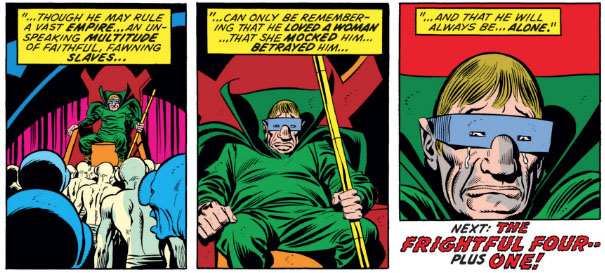 Doctor Doom then appears in a 'pin-up' page by John Buscema, the first in a series called "The Fabulous FF's Friends... and Foes!"
Doctor Doom then appears in a 'pin-up' page by John Buscema, the first in a series called "The Fabulous FF's Friends... and Foes!"
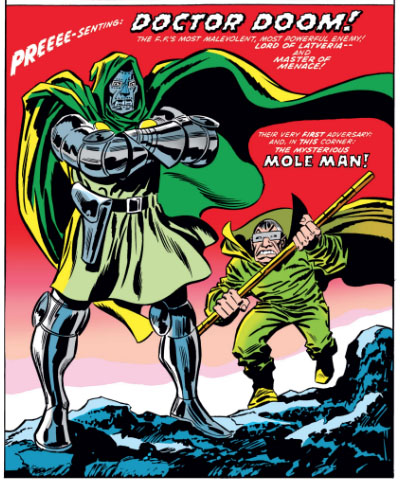 This image by John Buscema would be used again and again, in merchandising and in the comics themselves, as a template for Doom's overall design, defining how the character will look from now on. It does little things like stabilising the size of his bright yellow cloak clasps and formalising the design of his armour, especially the boots and gloves which have tended to change with different artists. It'll be interesting to see, the next time somebody other than Buscema draws him, whether they stick to this design.
This image by John Buscema would be used again and again, in merchandising and in the comics themselves, as a template for Doom's overall design, defining how the character will look from now on. It does little things like stabilising the size of his bright yellow cloak clasps and formalising the design of his armour, especially the boots and gloves which have tended to change with different artists. It'll be interesting to see, the next time somebody other than Buscema draws him, whether they stick to this design.
Sadly for the Mole Man, although this image will be re-used again and again, he will always be cut out, like a quickly dumped ex in a family wedding photograph. Poor old Mole Man!
posted 8/2/2019 by MJ Hibbett
(click here for permanent link)
(0) comments
Destination: Nightmare!
Doctor Doom only appears in flashback in this issue, in which the writer Archie Goodwin leans heavily on an old episode of 'Star Trek' and a tiny aspect of an even older issue of 'The Fantastic Four'.
The story begins with Bruce Banner falling through 'the microverse' (which would later be called 'The Quantum Realm' in the Marvel movies) as an overdose of shrinking serum causes him to get smaller and smaller. This leads to some excitingly psychedelic scenes, with Banner bashing into actual planets on his way down.
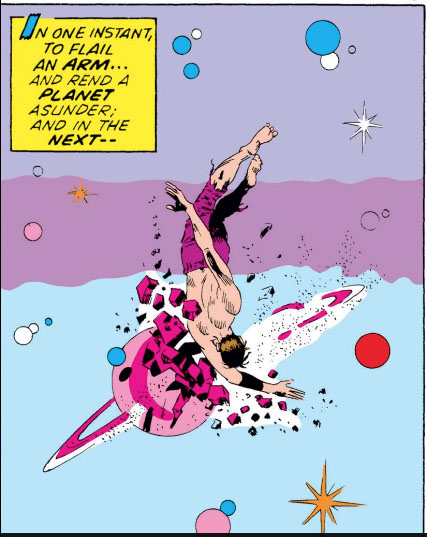 He eventually lands on a sidewalk, in a version of New York under attack from Nazi planes, and soon discovers that this is the world of The Shaper, a powerful being with the power to warp the world according to the dreams of those who live there. Sadly for the natives, their dreams were too dull, so when another "outworlder" arrived recently The Shaper latched onto his dreams instead, turning the planet into a version of Earth where the Nazis won World War 2.
He eventually lands on a sidewalk, in a version of New York under attack from Nazi planes, and soon discovers that this is the world of The Shaper, a powerful being with the power to warp the world according to the dreams of those who live there. Sadly for the natives, their dreams were too dull, so when another "outworlder" arrived recently The Shaper latched onto his dreams instead, turning the planet into a version of Earth where the Nazis won World War 2.
This is quite similar to the Patterns Of Force episode of the original series of Star Trek, where a History Professor imposes a version of Nazism on another planet. The episode was first broadcast in 1968, and would have been repeated since, so it's not unlikely that Archie Goodwin was aware of it.
The link to Doctor Doom comes from the fact that the 'outworlder' is an escapee from Doctor Doom's payroll called Otto Kronsteig, who was used as a test subject for the shrinking ray that Doom employed against the Fantastic Four back in Fantastic Four #10.
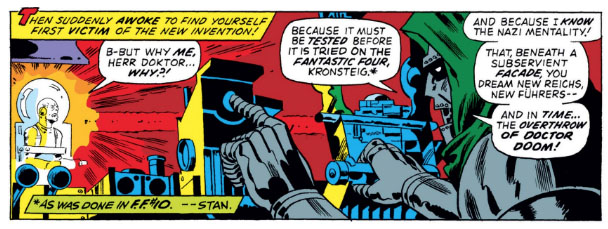 That was only Doom's third appearance, 18 months before his origin story revealed that he was an Eastern Europe dictator as well as a supervillain, so Goodwin is toying with continuity here, filling in some previously unseen back story. However, he does so using the version of Doom seen in Fantastic Four #86, who is happy to consort with former Nazis, rather than the heroic freedom fighter he would later become. Indeed, Kronsteig looks very similar to the former Nazi Hauptmann who Doom would later kill in that storyline.
That was only Doom's third appearance, 18 months before his origin story revealed that he was an Eastern Europe dictator as well as a supervillain, so Goodwin is toying with continuity here, filling in some previously unseen back story. However, he does so using the version of Doom seen in Fantastic Four #86, who is happy to consort with former Nazis, rather than the heroic freedom fighter he would later become. Indeed, Kronsteig looks very similar to the former Nazi Hauptmann who Doom would later kill in that storyline.
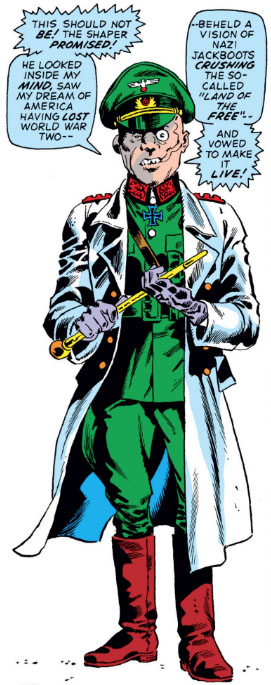
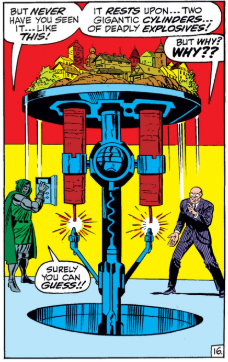 I wonder if perhaps Goodwin and/or Trimpe got confused about Doom's lackeys, and used the wrong Nazi? Either way, he is soon defeated by The Hulk, who is sent on his way through the Microverse by a penitent Shaper.
I wonder if perhaps Goodwin and/or Trimpe got confused about Doom's lackeys, and used the wrong Nazi? Either way, he is soon defeated by The Hulk, who is sent on his way through the Microverse by a penitent Shaper.
Doom's appearance here seems odd, like the definition of the character is retreating once more to the later Lee version rather than the more nuanced, sympathetic one that the likes of Gerry Conway and Roy Thomas have been introducing. It'll be interesting to see which version turns up next!
posted 6/2/2019 by MJ Hibbett
(click here for permanent link)
(0) comments
A Pulse-Pounding Publication
In a break from our advertised programme, I'm very happy to say that my first Doom-related academic publication is now available to view online!
The paper is called 'In Search of Doom. Tracking a Wandering Character Through Data' and it's available in the current issue (#29) of IMAGE: The Journal of Interdisciplinary Image Science. It's a discussion of the methods I used to generate the corpus of texts for this project, and as well as the usual help I got from my supervisors, Roger Sabin and Ian Horton, I also had a HUGE amount of advice and editing from Lukas Wilde, who ran the original conference where this was first presented.
I hope it's of interest - next time, back to the actual comics!
posted 5/2/2019 by MJ Hibbett
(click here for permanent link)
(0) comments
The Way It Began!
Doctor Doom's first appearance in this new era of the Marvel Age is a very minor one, although the story he appears in is an interesting one.
He appears right at the start, in a splash page which seems to show him murdering Sue Richards.
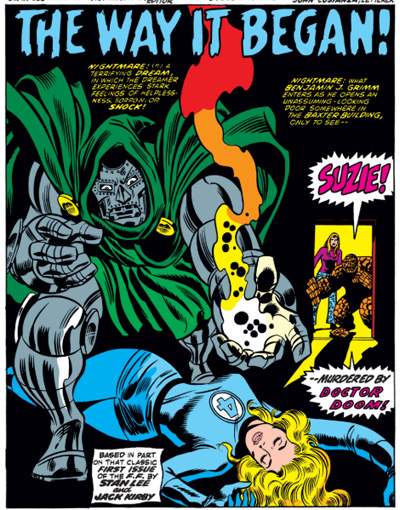 However, when The Thing tries to help it turns out to just be a hologram, generated by Reed Richards using his new improved Thought Projector Helmet. Apparently the best way to test it was to think of the most repulsive thing he could imagine, which was Doom killing his wife. The Thing, quite rightly, points out that this is a bit of a strange way to go about research.
However, when The Thing tries to help it turns out to just be a hologram, generated by Reed Richards using his new improved Thought Projector Helmet. Apparently the best way to test it was to think of the most repulsive thing he could imagine, which was Doom killing his wife. The Thing, quite rightly, points out that this is a bit of a strange way to go about research.
That's all there is of Doom, with the rest of the issue seeing The Thing and Human Torch use the Thought Projector Helmet to re-tell the events of their first issue, including their origin and first adventure with The Mole Man. Re-telling a superhero's origin story is almost obligatory for a new creative team, re-working it, or focusing on different aspects, as a declaration of intent for how they intend to write and/or illustrate the series. Here Roy Thomas re-uses much of the dialogue from the original story, while John Buscema re-draws the characters to be much more in line with their current looks. This is not unusual, but does lead to one weird moment when the Thing recalls his original, more monster-like design.
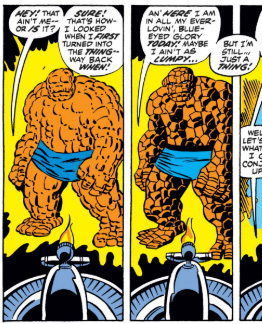 A few pages later, Buscema draws Ben Grimm transferring into the more rocky figure that had become familiar in recent years.
A few pages later, Buscema draws Ben Grimm transferring into the more rocky figure that had become familiar in recent years.
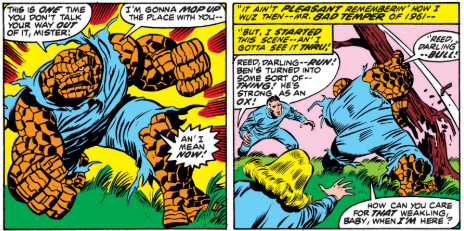 Future revisions of the Fantastic Four's origins would keep the original, lumpy, version of The Thing as part of the story, with John Byrne even reverting the character to this original look for a while, but here it's introduced only to be ignored a few pages later.
Future revisions of the Fantastic Four's origins would keep the original, lumpy, version of The Thing as part of the story, with John Byrne even reverting the character to this original look for a while, but here it's introduced only to be ignored a few pages later.
Otherwise it's a straightforward re-telling which seems to be there primarily to acknowledge what has gone before, possibly to reassure long-term readers that this is the same story they've enjoyed before, even if the original creators are now gone. The 'Stan's Soapbox' section of 'Bullpen Bulletins' in this issue takes up almost a full page, as Stan Lee explains to readers that's he's handing over Marvel's editorial reins to Roy Thomas so he can go off in search of new markets for their characters. With that in mind it's not surprising that Roy Thomas chose to include Doom. As a central part of The Fantastic Four it wouldn't really be a new starting point without him, but it would be quite a while before he returned to his 'home' series in an actual story.
posted 1/2/2019 by MJ Hibbett
(click here for permanent link)
(0) comments